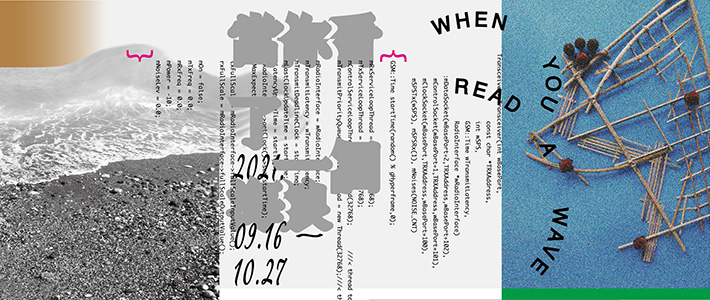當你看了一個海浪 When You Read a Wave

主辦人/單位:
主辦:花蓮市公所,協辦:北角工作室
活動類別:
展覽
首次展演日期:
2021-09-16
結束展演日期:
2021-10-27
詳細時間說明:
9/16(四) ~ 10/27(三)
活動地點:花蓮市北濱海灘及各定點
關於展演:地點:花蓮市北濱海灘及各定點
展期:2021.09.16 - 10.27
開幕:2021.09.16 15:00-16:30 (花蓮市北濱海灘)
藝術家座談:2021.09.25 14:00-15:30 (線上座談)
藝術家:邱承宏、李德茂.高任翔、鄭文琦、鄭先喻
活動詳情請見:https://fb.me/e/1IjJUZv2s
本展覽由花蓮市公所主辦、北角工作室協辦,由策展人李德茂策劃,邀請《水泥動物園》(邱承宏)、《海浪、小石頭與帕洛瑪先生》(李德茂、高任翔)、《沙箱》(鄭先喻)、《南洋放送局》(鄭文琦),來到花蓮市北濱海灘展出。
策展論述
歡迎來到海邊!海浪拍打在岸上,讓小石頭在水裡發出滾動的聲音。「帕洛瑪先生看著一個海浪在遠處升起、增長、向前逼近、變換形狀和色彩、碎裂、消散,然後再次湧起。」這是一個海旁邊的城市,自從人類來到這裡,長久以來和海的關係總是擺盪在緊密和疏離這兩端。
展覽主題取自1983年義大利作家伊塔羅.卡爾維諾的小說《帕洛瑪先生》。他從觀察一個海浪開啟了整部小說的旅程,關於動物、植物生長、行星、宇宙的縝密觀察和思緒蔓延。「那是一種日記,處理最細微的知識問題、與世界建立關係的方法、以及在運用沉默與語言方面的滿足與挫折。」帕洛瑪先生對這個世界充滿好奇,他總是想得很多,把沈思隱藏在細細的觀察中。
小說呈現了一種專注於經驗本身的敘述過程,展覽所在的北濱海灘連接著太平洋陡降的海底,不論在時間或空間上,似乎都構成了一股垂直的力量。不同時期的人們都曾參與他們與海洋的關係,海的不遠處是黑潮,附近花崗山文化的史前人可能就是透過這股洋流推進到其他的地方。如果往北一點,在一百年前有一群與海為生的人們,循著海上的鳥踏石移居到現今花蓮港的位置。循著海洋的開闊與多變,本展覽試圖讓作品來到海邊各自表達,提出關於城市與海洋的視角,每個人都可以自由的進出,並且觸發各種可能。對於離海很近,又與海相對陌生的城市或者島國,人與海的關係將如何形成?是否適合一種中心化或非中心化的思想路徑在此行進?藝術的角色為何,是一種打開或者遮蔽?或許多重維度的提問與親臨現場,將能擴大經驗的可能性。
文 李德茂/策展人
-
Curatorial Discourse
Welcome to the beach! The waves slapped on the shore, causing small rocks to make rolling sounds in the water. “Mr. Palomar sees a wave rise in the distance, grow, approach, change form and color, fold over itself, break, vanish, and flow again.” This is a city next to the sea. However, since humans came here, their relationship with the sea has always been swinging between close and distant.
The exhibition concept is inspired by the novel “Mr. Palomar” by Italian writer Italo Calvino in 1983. The journey of the whole novel started from Mr. Palomar reading a wave, expanding to his careful observation and thoughts on animals, plant growth, planets, and the universe. “It is a kind of diary dealing with minimal problems of knowledge, ways of establishing relationships with the world, and gratifications and frustrations in the use of both silence and words.” Mr. Palomar has a lot of curiosity about the world around him, and he always thinks a lot, concealing his contemplation in detailed observation.
The novel presents a narrative process that focuses on the experience itself. The Beibin Beach where the exhibition takes place is connected to the steep seabed of the Pacific Ocean, which seems to constitute a vertical force in both time and space. People of different periods of time have been connected with the ocean in one way or another. Not far from the beach flows the Kuroshio Current, which might support the prehistoric people of the nearby Huakangshan Culture in moving to other places. If you go a little bit north, a hundred years ago, a group of people who lived by the sea migrated to the current location of Hualien Harbor, following the bird stepping stones on the sea. With the openness and variability of the sea, this exhibition attempts to bring the artworks to the beach and let them express themselves, proposing a perspective on the relationship of the city and the sea. The exhibition welcomes the visitors to come and go freely, enabling all kinds of possibilities to be inspired. For cities or island countries that are very close to the sea but relatively unfamiliar with it, how is the relationship between people and the sea formed? Is it appropriate to develop a centralized or decentralized mindset? What is the role of art? Does art lead to openness or masking? Perhaps through asking questions from multiple viewpoints and visiting on-site will open up more possibilities for experience.
Text by LEE Te-Mao / Curator
費用說明:
免費







